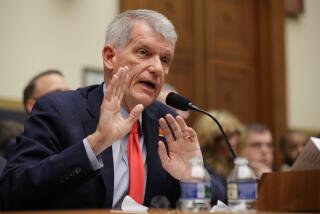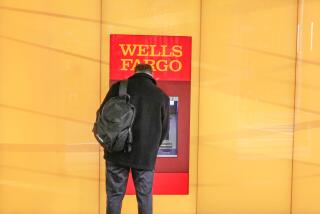Wells Fargo’s estimate for unauthorized accounts jumps 67%, to 3.5 million
Wells Fargo & Co. said Thursday it may have created as many as 3.5 million checking, savings and credit card accounts without customers’ authorization over the last eight years — a number that is similar to an estimate in a class-action case but one that far exceeds the bank’s initial accounting of its sham-accounts scandal.
The question of just how many unauthorized accounts were created has loomed over the San Francisco institution since it agreed to pay $185 million to regulators after acknowledging the existence of as many as 2.1 million such accounts opened over a four-year period that ended in mid-2015.
But this spring, the bank agreed to settle several class-action lawsuits over the matter for $142 million, and the plaintiffs attorneys who negotiated the deal estimated that some 3.5 million accounts were created since 2002.
The bank on Thursday released a statement, based on a long-awaited independent report it had commissioned from accounting firm PwC, that concluded as many as 3.5 million sham accounts were created, though in a shorter time period dating from January 2009.
Wells Fargo Chief Executive Tim Sloan, in a conference call, called the new figure “a reminder of the disappointment we caused” to customers and investors, adding the bank lacked the records to expand the review to an earlier date.
Though the new, larger figure was not a total surprise, it gave new ammunition to critics of the bank.
Sen. Elizabeth Warren (D-Mass.) renewed her call for the Federal Reserve to oust more members of Wells Fargo’s board over the still-growing scandal. And Rep. Maxine Waters (D-Los Angeles), the ranking Democratic member of the House Financial Services Committee, said in a statement that the bank should be broken up.
“Wells Fargo’s misdeeds are egregious, and they must be held accountable for their many abuses of American consumers,” Waters said. “Wells Fargo has made a routine practice of ripping off and preying on their customers, in a seemingly never-ending avalanche of scandals.”
Indeed, the larger sham accounts figure is only the latest in a series of admissions, mea culpas and management changes the company has made as it continues to try to put the scandal behind it.
Over the last six weeks alone, the bank has admitted charging hundreds of thousands of auto loan customers for insurance policies they didn’t need, reported that federal regulators are looking into claims mortgage borrowers were forced to pay excessive fees and has been sued over allegations that its credit-card processing division gouged small-business customers.
Amid the seemingly unending stream of bad news, the bank announced in August that Stephen Sanger, a longtime board member who took over as the bank’s chairman in the early days of the scandal, will step down at the end of the year.
His departure and that of two other long-serving directors mark the highest-profile exits from the bank since former Chairman and Chief Executive John Stumpf resigned about a month after the Sept. 8 settlement.
Wells Fargo’s practices were first uncovered in a 2013 Los Angeles Times story that found workers, faced with overbearing pressure from management, were creating sham accounts so they could meet sales goals. In many cases, customers paid fees on those unauthorized accounts or faced potential damage to their credit scores because of unapproved credit inquiries and unknown fees.
After the story, Los Angeles City Atty. Mike Feuer began investigating the bank, and his office sued Wells Fargo in 2015. The $185-million settlement was shared by Feuer’s office and two federal regulators: the Consumer Financial Protection Bureau and the Office of the Comptroller of the Currency.
Soon after, during a bruising Capitol Hill hearing, then-CEO Stumpf said the bank would review accounts created as far back as 2009 and as recently as September 2016. The new estimate of 3.5 million potentially unauthorized accounts is based on that review, which looked at more than 165 million accounts.
The review found that 190,000 of those accounts incurred fees or charges, up from an earlier estimate of 130,000 accounts. The study also found that about 528,000 accounts were potentially enrolled in online bill pay without customers’ knowledge or consent. The bank said it would refund $910,000 to those customers who incurred fees or charges. Payouts from the $142-million class-action settlement would be on top of those refunds.
The bank had known for weeks that the new review would identify a larger number of potentially unauthorized accounts. Last week, Sloan sent a letter to employees warning that there would be a wave of news coverage after the announcement of the new figures.
“The results of our reviews will generate news headlines,” Sloan wrote, “but even as we face this renewed coverage, the best thing we can do is stay focused on fixing problems, making things right for customers, and building a better, stronger Wells Fargo.”
Still, despite the expanded review, it remains unclear exactly how many unauthorized accounts were created in all. Sloan said the bank could only review back to 2009 because that is the year it acquired Charlotte-based bank Wachovia.
“That was a big demarcation in terms of data,” Sloan said. “The farther you go back, the data is just not as available or of as high quality.”
The ongoing scandal has taken a toll on the bank’s retail business, which has seen fewer customers open new accounts than in the past. In January, the bank announced a plan to trim expenses by $2 billion by 2018, and in May, it announced plans to cut $2 billion more by the end of 2019.
Wells Fargo shares fell 29 cents, or 0.6%, to $51.07 on Thursday, their lowest point since late last year.
Analysts who follow the bank said they weren’t surprised by Thursday’s announcement, but they’re still waiting to see what other bad practices the bank may divulge and how management and the board will handle new developments.
Cathy Seifert, an analyst at research firm CFRA, said it’s inevitable that there will be more bad news.
“More stuff is going to come out,” she said. “The question is, what is the board going to do, and what will regulators do?”
Twitter: @jrkoren
Twitter: @smasunaga
ALSO
Opinion: Stop the next Wells Fargo scandal before it happens
Wells Fargo hit with class-action lawsuit over mortgage lock-in fees
Wells Fargo charged customers for unneeded auto insurance — then repossessed their cars
UPDATES:
9:10 a.m.: This article was updated with more information about the independent review and details from a conference call held Thursday morning.
7:30 a.m.: This article was updated with more information about the independent review and background information.
6:40 a.m.: This article was updated with a statement from Wells Fargo Chief Executive Tim Sloan and more findings from the independent review.
This article was originally published at 6:20 a.m.
More to Read
Inside the business of entertainment
The Wide Shot brings you news, analysis and insights on everything from streaming wars to production — and what it all means for the future.
You may occasionally receive promotional content from the Los Angeles Times.












